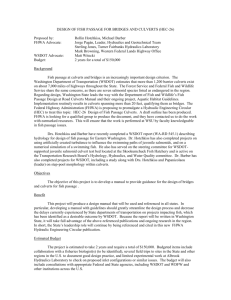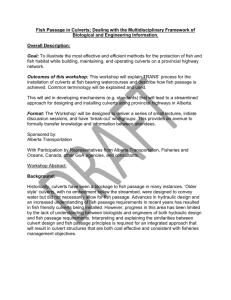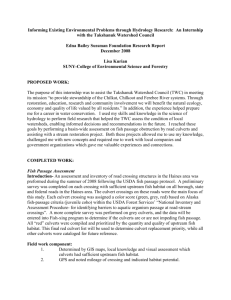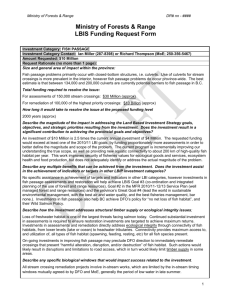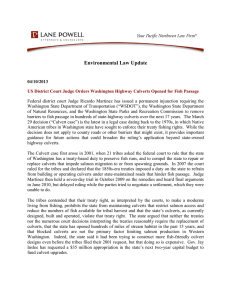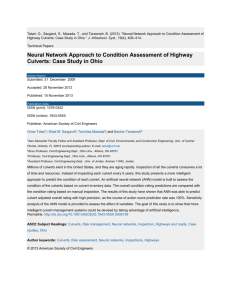A primer on fish passage barriers
advertisement
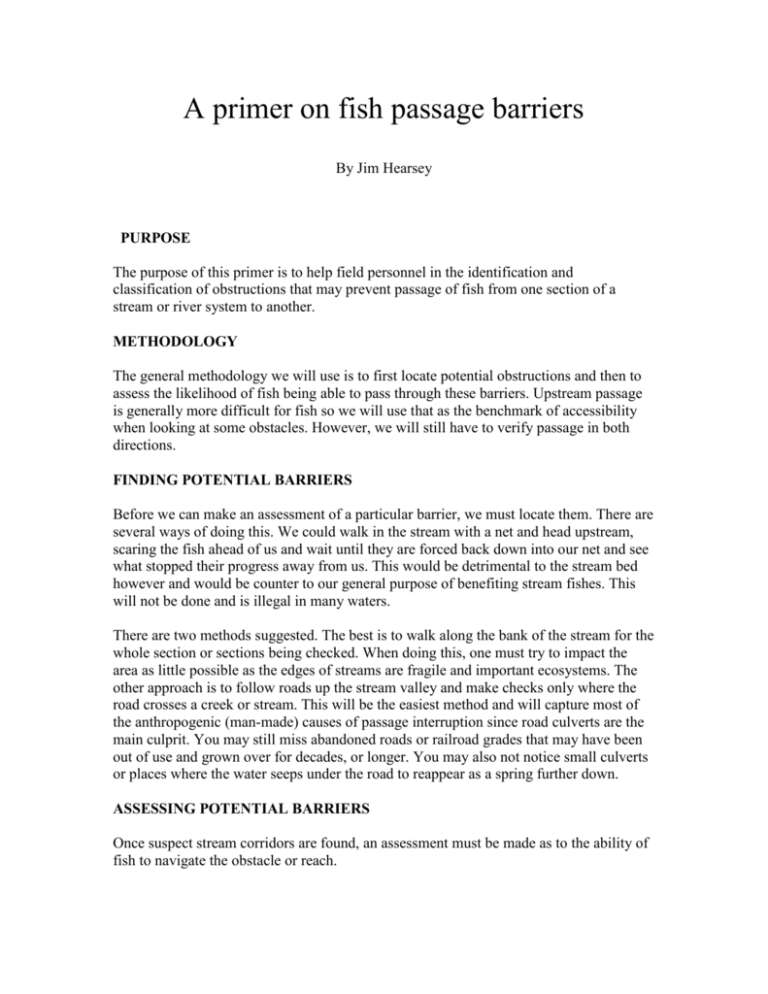
A primer on fish passage barriers By Jim Hearsey PURPOSE The purpose of this primer is to help field personnel in the identification and classification of obstructions that may prevent passage of fish from one section of a stream or river system to another. METHODOLOGY The general methodology we will use is to first locate potential obstructions and then to assess the likelihood of fish being able to pass through these barriers. Upstream passage is generally more difficult for fish so we will use that as the benchmark of accessibility when looking at some obstacles. However, we will still have to verify passage in both directions. FINDING POTENTIAL BARRIERS Before we can make an assessment of a particular barrier, we must locate them. There are several ways of doing this. We could walk in the stream with a net and head upstream, scaring the fish ahead of us and wait until they are forced back down into our net and see what stopped their progress away from us. This would be detrimental to the stream bed however and would be counter to our general purpose of benefiting stream fishes. This will not be done and is illegal in many waters. There are two methods suggested. The best is to walk along the bank of the stream for the whole section or sections being checked. When doing this, one must try to impact the area as little possible as the edges of streams are fragile and important ecosystems. The other approach is to follow roads up the stream valley and make checks only where the road crosses a creek or stream. This will be the easiest method and will capture most of the anthropogenic (man-made) causes of passage interruption since road culverts are the main culprit. You may still miss abandoned roads or railroad grades that may have been out of use and grown over for decades, or longer. You may also not notice small culverts or places where the water seeps under the road to reappear as a spring further down. ASSESSING POTENTIAL BARRIERS Once suspect stream corridors are found, an assessment must be made as to the ability of fish to navigate the obstacle or reach. There area many known barriers to fish passage in scientific literature. These include aggressive predation through loss of cover and point source pollution. We will ignore these issues in this paper. We will be looking for physical barriers having to do with water flow only. These barriers include; low flow reaches where the stream is too shallow, culverts and dams. Shallow water The Washington state Department of Fish and Wildlife has recommendations (http://www.wdfw.wa.gov/hab/engineer/cm/culvert_manual_final.pdf) of minimum water depths that fish can traverse. The depths vary with species, but we shall use the deepest requirement to be conservative. They use 1 foot as a requirement for some salmon species. This is a very conservative estimate and certainly most native fish can handle this shallow water for quite a distance (large sturgeon excepted). If the person in the field feels that the reach is below this depth for a significant distance and has the potential to be a barrier it should be noted and reviewed. Note: there may actually be sufficient water here for passage but it is spread over these rocks. That was the case here before restoration. Culverts Culverts are the main impediment to salmon that is man made. They come in many shapes. Once again, the WDFW (http://www.wdfw.wa.gov/hab/engineer/cm/culvert_manual_final.pdf) has a mathematical formula for ascertaining the ability of different salmon species to traverse culverts. The Canadian government in B.C. has the following recommendations (http://www.th.gov.bc.ca/publications/eng_publications/environment/references/Culverts _and_Fish_Passage.pdf); Grade Not to exceed .5% for culverts more than 24 meters in length unless baffles are included. Not to exceed .5% for more culverts less than 24 meters in length unless baffles are included. Not to exceed 5% at any time Length Culverts under 24 meters in length can have water velocities up to 1.2 m/sec Culverts over 24 meters in length can have water velocities up to .9 m/sec Water depth should be at natural levels or at least .23 meters at all times. Drops at outlets should not exceed 1 foot, approximately 1 foot. These recommendations were for new installations. In the field, pictures should be taken of all suspect conditions for further analysis. The main obstacle to fish passage with regard to culverts is the incident of a vertical drop from the lip of the downstream end of the culvert which fish must jump. Note the use of natural substrate for bottom of culvert. Plunges like this restrict passage. DAMS There may be buried, abandoned or obscured small man-man made dams along a stretch of stream. According to the British Columbian Ministry of Transportation (http://www.th.gov.bc.ca/publications/eng_publications/environment/references/Culverts _and_Fish_Passage.pdf), all spills should be no more than .31 meters, or about 1 foot. Here is an abandoned dam that stops fish passage. CONCLUSION Finding and assessing fish barriers is a skill that will take plenty of field hours to master. The main goal is survey as much of the stream as possible and to take note of any suspect sections for further review.

